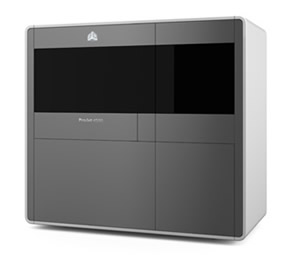
3D System’s ProJet 4500 claims to be the only “continuous tone, full-color plastic 3D printer” on the market. It is capable of printing models with nearly one million colors. The ProJet 4500 accomplishes this through the use of a proprietary plastic powder called VisiJet C4 Spectrum.
Every part of a 4500 model can be imbued with color thanks to the ProJet 4500’s 0.1mm axis resolution. Furthermore, the machine’s color printing technology allows its models to showcase either seamless color gradients or abrupt color switches depending on a user’s input.
While the features of the ProJet 4500 might sound a lot like the ProJet 660, the 4500 is actually a much more versatile machine. The main point of difference between the 660 and the 4500 centers on the materials that each printer uses. While the 600 uses a gypsum-based powder the 4500 uses a polymer stock. Leveraging the strength inherent in plastics, the 4500 is capable of producing parts that can withstand conditions that would cause a 660 model to break.
Because of its added strength the ProJet 4500 has a greater application portfolio than the 660. Functional models as well as high-quality display prototypes can be created using the 4500.
Because of its added strength the ProJet 4500 has a greater application portfolio than the 660. Functional models as well as high-quality display prototypes can be created using the 4500.
According to Steve Cory of Objex Unlimited, the ProJet 4500 is a perfect complement to his company’s ProJet 660. “With the 4500 we’re able to build any models that we think would be too delicate to build on the 660”. Aside from being more robust Cory was also quick to point out that the 4500 excels at printing thin-walled, complex parts for both mechanical and architectural applications.
Diving into the mechanics of the ProJet 4500, Steve also complimented the system’s Piezo-style printhead technology: “With the 4500 we don’t see any costly, time consuming printhead changes. For that reason we can run the 4500 with little to no downtime.”
Read more at ENGINEERING.com

